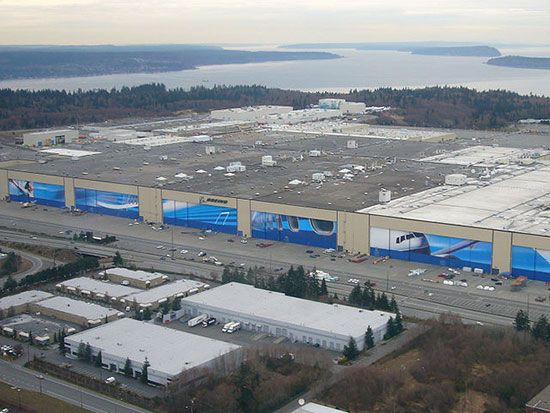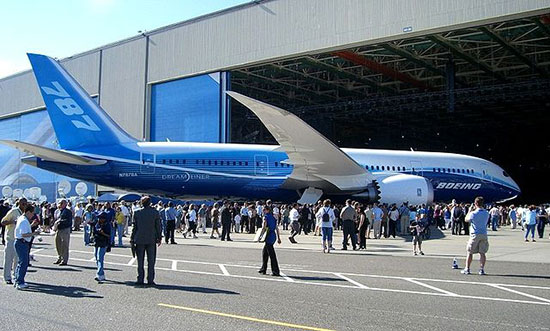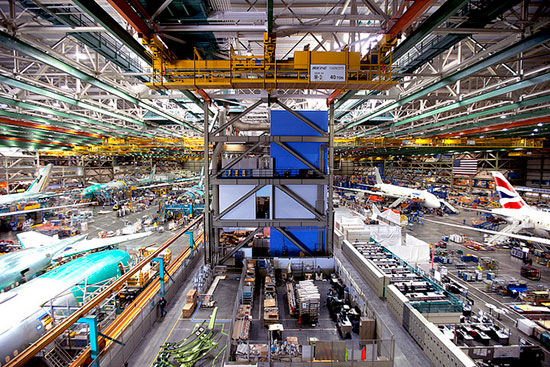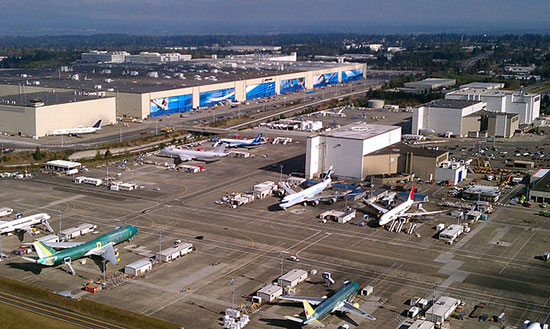Something Big
by Andrew Boyd
Today, something really big. The University of Houston's College of Engineering presents this series about the machines that make our civilization run, and the people whose ingenuity created them.
What's the world's largest building? Not the tallest, but the building with the most enclosed space. Maybe shopping malls or downtown convention centers come to mind. Perhaps those massive domed sports stadiums? None even come close.
The world's largest building is an aircraft assembly plant in Everett, Washington, about twenty-five miles north of Seattle. It's the birthplace of Boeing's largest planes. In the forty-four years leading up to 2012, when a new Dreamliner plant opened, every wide body aircraft made by Boeing rolled out the doors of this immense garage.

Boeing Everett Factory [Wikipedia/Maurice King]
Impetus for the structure came when Boeing signed a contract in 1966 to deliver twenty-five 747s to Pan Am. Boeing purchased land for the building site, and in less than a year the first major assembly building opened.
The original facility was large enough that even today it would still place first on the list of the world's largest buildings. Over time, it's more than doubled in size. Nineteen-eighty saw the facility expanded for the production of 767s, and 1993 for 777s. Room for the first Dreamliners came from re-organizing what space was already there.

Boeing 787 Dreamliner at roll-out ceremony, 2007 [Wikipedia/Yasuhiko Obara Yasobara]
When the Houston Astrodome was completed in 1965 it was touted as the eighth wonder of the world. When the Boeing plant was completed three years later, it contained the enclosed space of eleven Astrodomes. Because the plant ceiling is lower than that of a typical sports stadium, its enormous volume translates to a vast footprint. There's enough floor space for seventy-five football fields, or, if you prefer, one regulation golf course.

Boeing Everett Factory, 787 production line [flickr/Jetstar Airways]
The second largest building in the world is a little more than half the size of the Boeing facility — a distribution warehouse for Target located about fifty miles south of Seattle. And in third place at just under half the size? No surprise here. It's the final assembly plant for the Airbus A380, located in Toulouse, France.
Structures this size pose new engineering challenges. For example, weather. When the Boeing plant first opened, clouds would form near the ceiling. The problem precipitated the inclusion of a new air circulation system. Then there's the question of decoration. The six colossal hangar doors on the plant's south side, each over a football field wide, are covered with a beautiful blue mural.
It's quite a sight to see. And not just the building, but the many planes in the parking lot, painted with logos from around the globe, all waiting for airline dignitaries to arrive and shuttle home their newborns like proud parents. As you can imagine, new planes are a big deal.

Boeing Everett Factory [Wikipedia/Jeremy Elson]
And you can see it all. Boeing offers an inexpensive tour of the grounds and facility. It's definitely well worth the time for a visit. Just be sure to take your best walking shoes.
I'm Andy Boyd at the University of Houston, where we're interested in the way inventive minds work.
(Theme music)
Notes and references:
For the record, the Reliant Astrodome has a volume of roughly 43 million cubic feet with the new Reliant Stadium running a little more than twice that — around 90 million. The Boeing plant in Everett has an interior volume of 472 million cubic feet.
Everett Tour, Background Information. From the Boeing website: http://www.boeing.com/boeing/commercial/facilities/index.page. Accessed October 22, 2013.
History of Boeing and the Everett Site. From the Boeing website: http://www.boeing.com/boeing/commercial/tours/background.page. Accessed October 22, 2013.
The picture of the interior of the Everett plant is from flickr. All other pictures are from Wikimedia Commons.
This episode first aired on October 23, 2013.